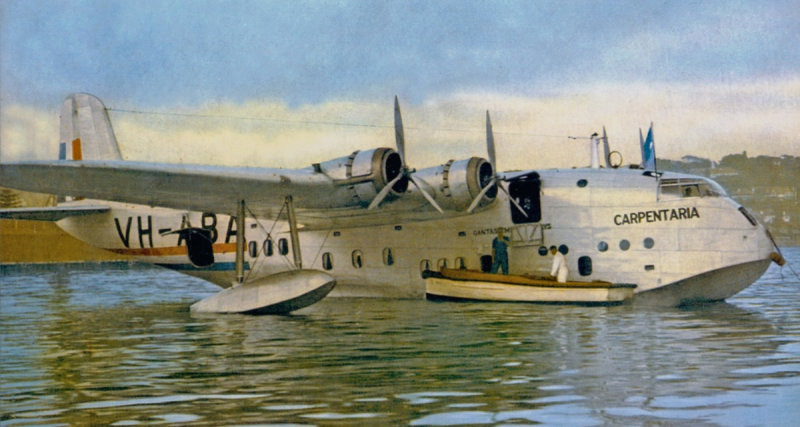A Look At Qantas' Flying Boat Origins
By: Andrew Curran (Simple Flying)


A bit of interesting history. Commercial aviation as we know it today got its start during the 1930s in the midst of the Great Depression. Today's efforts to introduce electric powered aircraft into the commercial travel market is confronting some of the same issues experienced in the 1930s with low powered aircraft of limited range. The beginnings of commercial aviation may provide valuable lessons if electric powered aircraft are to succeed.

Qantas operated flying boats for around ten years from the late 1930s. The airline first operated a fleet of Empire flying boats and later on Catalinas. Those flying boats were unashamedly elitist and ludicrously expensive to fly on, but their origins were far more prosaic.
Qantas bags a lucrative airmail contract
By the time the first two Qantas flying boats landed in Sydney in 1938, the airline had been operating for less than 20 years. Those first two decades weren't easy for Qantas. Money was tight, and business was difficult.
One steady source of income was government contracts, especially mail contracts. Around this time, airlines and aviators were trying to snare valuable contracts to prop up their fledgling operations.
Much to the despair of competitors like Charles Kingsford Smith, who was struggling to make a success of Australian National Airways, a joint Qantas/Imperial Airways bid for the Australia - United Kingdom airmail contract in the early 1930s was successful. This contract underpinned the arrival of the flying boats at Qantas.
While far quicker than traveling by sea, flying between Australia and the United Kingdom in the 1930s was no easy exercise. Captain Ross Macpherson Smith and co-pilot Lieutenant Keith Macpherson Smith, along with mechanics Sergeant Wally Shiers and Sergeant Jim Bennett, first made the flight in 1919. That flight took 136 hours (and 15 stops) to fly between Hounslow Heath and Darwin.

11 stops to Singapore on a Qantas Empire flying boat
A decade or two later, aircraft were still flying only short distances before needing refueling. But aircraft had gotten bigger, and there were not many runways around to handle bigger planes. Flying boats were a solution as it was usually easier to find a patch of water to land on than a runway - especially when on a long flight.
Until the Empire flying boats arrived, Qantas used De Havilland Aircraft Company DH86 planes to service their leg of the mail contract (between Australia and Singapore). In 1938, the flying boats took over the run.
These days, it takes around eight hours to fly between Sydney and Singapore direct. Things were slightly more complicated in 1938. After taking off from Sydney's Rose Bay, the Empire flying boat would head up to Townsville via Brisbane and Gladstone for the night. The next day, the plane would go onto Darwin via Karumba and Groote Eylandt. After another night's rest, it was onto Singapore via Kupang, Bima, Surabaya, and Jakarta.
In Singapore, pilots would transfer the mail bags (and passengers) into the care of British Imperial Airways to continue on to London via South Asia, the Middle East, and southern Europe.

A short-lived flying boat era
World War II interrupted the flying boat services. They were requisitioned for the war effort. But by the end of the war, nearly all the Empire flying boats had either crashed or been destroyed in enemy attacks.
As Qantas got back into the business of flying mail and passengers after the war, it was busy introducing the Catalinas. Those Catalinas could fly further, faster, and would go on to become an iconic Qantas plane.
But the flying boat era was ending almost as quickly as it began. The war saw aviation infrastructure develop. Traditional turboprop aircraft had advanced in leaps and bounds, and the jet age was looming. On the ground, there were more airports and longer runways.
Suddenly, landing on the Brisbane River wasn't the convenient workaround as it was just a decade previously. In 1947, Lockheed Constellations began flying between Sydney and London. Aircraft like the Constellations thoroughly outgunned the flying boats.
However, non-Qantas branded flying boats continued to have a presence in Australia until the 1970s, particularly around northern Australia on domestic flights. Australia's last regular flying service was between Sydney and Lord Howe Island, which ended in the mid-1970s.

Tags
Who is online
506 visitors


With growing interest in electric powered aircraft, commercial aviation of the 1930s is becoming relevant again.
Good video! Thanks for posting.
The flying boats were long gone before I started traveling by air. But I'd try it at least once. To me, it's more appealing than a cruise ship vacation.
The Short S23 C was developed in parallel with the Short Sunderland flying boat. S23 C was designed for the civilian airlines while the Sunderland was designed for RAF use as a maritime patrol bomber, anti submarine warfare, and reconisance aircraft. Both aircraft share many of the same components and looked very similar.
Deleted duplicate
Morning..
Yep I always go by the flying Kangaroo, especially on long haul flights...
What a difference now Australia to UK..24 hours...